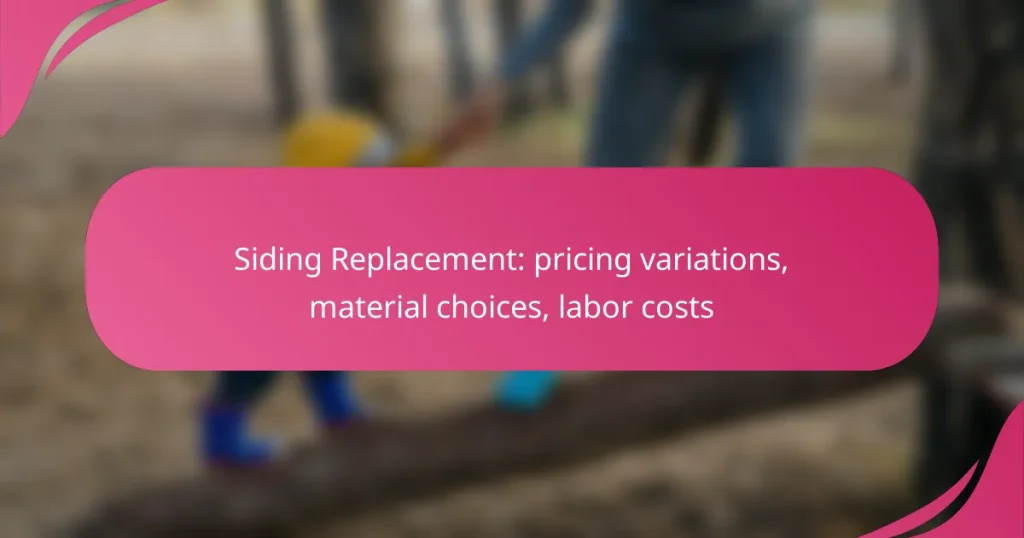Siding replacement is an important home improvement project that offers various options, each with distinct characteristics and costs. In Canada, prices typically range from CAD 5 to CAD 15 per square foot, influenced by material choices and labor expenses. Homeowners should carefully consider these factors to make informed decisions that align with their budget and aesthetic preferences.

What are the siding replacement options in Canada?
In Canada, homeowners have several siding replacement options, each with unique characteristics, costs, and maintenance requirements. The choice of siding material can significantly impact the overall aesthetics, durability, and energy efficiency of a home.
Vinyl siding
Vinyl siding is a popular choice due to its affordability and low maintenance. It typically costs between CAD 3 to CAD 8 per square foot, making it an economical option for many homeowners.
This material is available in various colors and styles, allowing for customization. However, it can be prone to fading and may not withstand extreme weather conditions as well as other materials.
Wood siding
Wood siding offers a classic look and natural appeal, often costing between CAD 6 to CAD 12 per square foot. It can be painted or stained to match the homeowner’s preferences, providing versatility in design.
While wood siding can enhance a home’s curb appeal, it requires regular maintenance to prevent rot and insect damage. Homeowners should consider the long-term upkeep when choosing this option.
Fiber cement siding
Fiber cement siding is known for its durability and resistance to fire, insects, and rot, with costs ranging from CAD 5 to CAD 10 per square foot. This material mimics the appearance of wood or stucco while offering superior longevity.
Installation can be more labor-intensive, leading to higher labor costs, but the investment often pays off through lower maintenance needs and longer lifespan compared to wood or vinyl.
Metal siding
Metal siding, including aluminum and steel, is valued for its strength and modern aesthetic, typically costing between CAD 7 to CAD 15 per square foot. It is resistant to pests and fire, making it a safe choice for many climates.
However, metal siding can be prone to dents and scratches, and its thermal conductivity may lead to higher energy costs if not properly insulated. Homeowners should weigh these factors when considering metal siding.
Stucco siding
Stucco siding is a durable option that provides a unique texture and is commonly used in warmer climates, costing around CAD 6 to CAD 9 per square foot. It is made from a mixture of cement, sand, and lime, offering excellent insulation properties.
While stucco requires minimal maintenance, it can crack over time, especially in regions with significant temperature fluctuations. Proper installation and sealing are crucial to prevent moisture issues and ensure longevity.

How much does siding replacement cost in Canada?
Siding replacement in Canada typically ranges from CAD 5 to CAD 15 per square foot, depending on various factors such as material choice and labor costs. Homeowners should consider these elements when budgeting for a siding project to ensure they make informed decisions.
Average cost per square foot
The average cost for siding replacement in Canada generally falls between CAD 5 and CAD 15 per square foot. This price range includes both materials and labor, but can vary based on the complexity of the installation and the specific siding type chosen.
For example, basic vinyl siding may cost around CAD 5 to CAD 8 per square foot, while higher-end materials like fiber cement or wood can reach CAD 10 to CAD 15 per square foot. Always obtain multiple quotes from contractors to get a clearer picture of your specific project costs.
Cost variations by material
The choice of siding material significantly impacts the overall cost of replacement. Vinyl siding is often the most economical option, while materials like wood, fiber cement, and metal can be more expensive due to their durability and aesthetic appeal.
Here’s a brief overview of common siding materials and their approximate costs per square foot:
- Vinyl: CAD 5 – CAD 8
- Wood: CAD 8 – CAD 12
- Fiber Cement: CAD 10 – CAD 15
- Metal: CAD 10 – CAD 14
Choosing a material should balance cost with long-term maintenance and durability considerations.
Factors affecting pricing
Other considerations include the complexity of the installation, such as the need for additional framing or insulation, and any required permits or inspections. Weather conditions can also affect project timelines and costs, so planning for seasonal considerations is essential.

What are the labor costs for siding replacement?
Labor costs for siding replacement typically range from a few thousand to several thousand dollars, depending on various factors such as location, material choice, and the complexity of the project. Understanding these costs is crucial for budgeting and selecting the right contractor.
Average labor rates in Canada
In Canada, average labor rates for siding installation generally fall between CAD 40 and CAD 70 per hour. This can translate to total labor costs of around CAD 1,500 to CAD 3,000 for a standard home, depending on the size and type of siding being installed.
Regional labor cost variations
Labor costs for siding replacement can vary significantly across Canada. Urban areas like Toronto and Vancouver often have higher rates, sometimes exceeding CAD 80 per hour, while rural regions may see rates as low as CAD 30 per hour. These differences can impact the overall project budget considerably.
Factors influencing labor costs
Several factors can influence labor costs for siding replacement. The complexity of the installation, such as the need for additional framing or repairs, can increase labor time and costs. Additionally, the choice of siding material, with some materials requiring more skilled labor, can also affect pricing.
Seasonality plays a role as well; demand for siding work typically peaks in warmer months, potentially driving up labor rates. It’s advisable to obtain multiple quotes and consider scheduling work during off-peak seasons to secure better pricing.

What factors influence siding material choice?
Several factors influence the choice of siding materials, including climate, durability, maintenance needs, and energy efficiency. Homeowners must consider how these elements align with their budget and long-term goals.
Climate considerations
Climate plays a crucial role in selecting siding materials. For instance, areas with heavy rainfall may benefit from materials like vinyl or fiber cement, which resist moisture and prevent rot. In contrast, regions with extreme temperatures might require siding that can withstand expansion and contraction without damage.
Additionally, homes in hurricane-prone areas should consider impact-resistant siding options to enhance safety. Understanding local weather patterns can help homeowners choose the most suitable material for their environment.
Durability and maintenance
Durability is a key factor in siding material choice, as it affects the lifespan and maintenance requirements of the siding. Materials like brick and fiber cement are known for their longevity, often lasting several decades with minimal upkeep. On the other hand, wood siding may require regular painting or staining to maintain its appearance and protect against decay.
Homeowners should weigh the initial cost against the long-term maintenance needs. Investing in more durable materials may lead to lower maintenance costs over time, making it a more economical choice in the long run.
Energy efficiency
Energy efficiency is increasingly important in siding selection, as it can impact heating and cooling costs. Insulated siding options can help reduce energy consumption by providing better thermal performance. Homeowners should consider materials with high R-values, which indicate better insulation properties.
Additionally, some siding materials can be combined with insulation to enhance energy efficiency further. Evaluating the energy performance of siding options can lead to significant savings on utility bills over time.

What are the benefits of different siding materials?
Different siding materials offer various benefits, including insulation, cost-effectiveness, and aesthetic appeal. Choosing the right material can significantly impact your home’s energy efficiency, budget, and overall appearance.
Insulation properties
Insulation properties vary widely among siding materials, affecting energy efficiency and comfort. For instance, vinyl and fiber cement siding provide decent insulation, while wood and insulated vinyl options can enhance thermal performance. Proper installation is crucial to maximize these insulation benefits.
Consider using insulated siding if you live in regions with extreme temperatures. This can help reduce heating and cooling costs, making your home more energy-efficient.
Cost-effectiveness
The cost-effectiveness of siding materials depends on initial costs, longevity, and maintenance requirements. Vinyl siding is often the most affordable option upfront, while materials like brick or stone may require a higher investment but offer longer lifespans and lower maintenance costs.
When evaluating cost, factor in both installation expenses and potential energy savings over time. For example, while wood siding may be cheaper initially, its susceptibility to rot could lead to higher long-term costs.
Aesthetic appeal
Aesthetic appeal is a significant consideration when selecting siding materials, as it influences your home’s curb appeal and value. Materials like wood and fiber cement can mimic traditional styles, while vinyl offers a wide range of colors and textures.
Choose a siding material that complements your home’s architectural style and the surrounding environment. For instance, modern homes may benefit from sleek metal siding, while classic designs often look best with wood or brick finishes.


